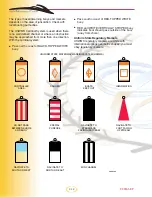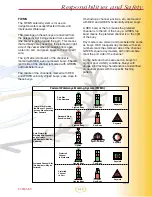
3-3
4. Keep accurate records of your fuel
consumption. A fuel log tracking fuel use over
time will help determine average consumption.
5. Close all doors, hatches, windows and other
compartments.
6. Extinguish cigarettes, pipes, and all other flame
producing items.
7. Make sure all power is off, and do not operate
any electrical switches.
8. Remove the fuel fill cap using the fuel cap key
supplied with your boat.
9. Insert the hose nozzle and make sure nozzle is
in contact with or grounded against fill opening.
This will reduce the risk of static spark.
10. Add fuel in accordance with the propulsion unit
operator’s manual. Do not overfill, and allow
enough room for fuel expansion.
NOTICE:
• Each time you refuel, inspect all fuel
lines, hoses and connections for
leaks and deterioration.
• The Federal Water Pollution Control
Act prohibits the discharge of oil or
oily waste into the water. Violators
can be fined $5,000.00. We urge you
to protect our fragile environment by
avoiding any type of discharge, trash
or litter into our waterways.
KC-0991
TYPICAL DECK PLATE KEY
KC-2047
After fueling:
1. Tighten the fuel fill cap using the fuel cap key.
Wipe up any fuel spillage.
2. Open all windows, hatches, doors and
compartments.
3. Check all fuel lines, hoses and connections for
leaks and deterioration.
4. Be sure to run the blower for at least four
minutes before starting the engines. If you
smell gasoline fumes, do not start the engines;
continue to run the blower until fumes have
dissipated.
Launching
Launching Checklist
Federal and local laws require certain safety
equipment to be on board at all times. In addition,
responsible boaters carry other equipment in case
of an emergency. Check with local boating
authorities for any additional requirements over
and above federal requirements.
For maximum enjoyment and safety, check each
of these items BEFORE launching:
●
Install drain plug.
●
Have enough life-saving devices for every
person onboard.
●
Be sure the steering system operates smoothly
and properly.
●
Verify the amount of fuel in the fuel tanks.
●
Verify the batteries are fully charged.
●
Check weather conditions.
●
Be sure the lights, horn, bilge pumps and other
electrical equipment are in operating
conditions.
●
Be sure the fire extinguisher, signaling devices
and other emergency gear are onboard and in
proper operating condition.
On the Water
Start your engines before casting off. Remember,
the boat turns from the stern; therefore, allow
plenty of space between the boat and the dock
before trying to move away.
Operating Information
Summary of Contents for 360
Page 1: ...Owner s Manual ...
Page 36: ...2 22 ...
Page 74: ...3 38 ...
Page 108: ...5 14 ...
Page 111: ...6 3 SERVICE LOG Date Hour Reading Service Repairs Performed Checklist Forms and Index ...
Page 112: ...6 4 FUEL LOG Date Gallons Hours Gallons Hour Date Gallons Hours Gallons Hour ...
Page 118: ...6 10 ...
Page 119: ......
















































